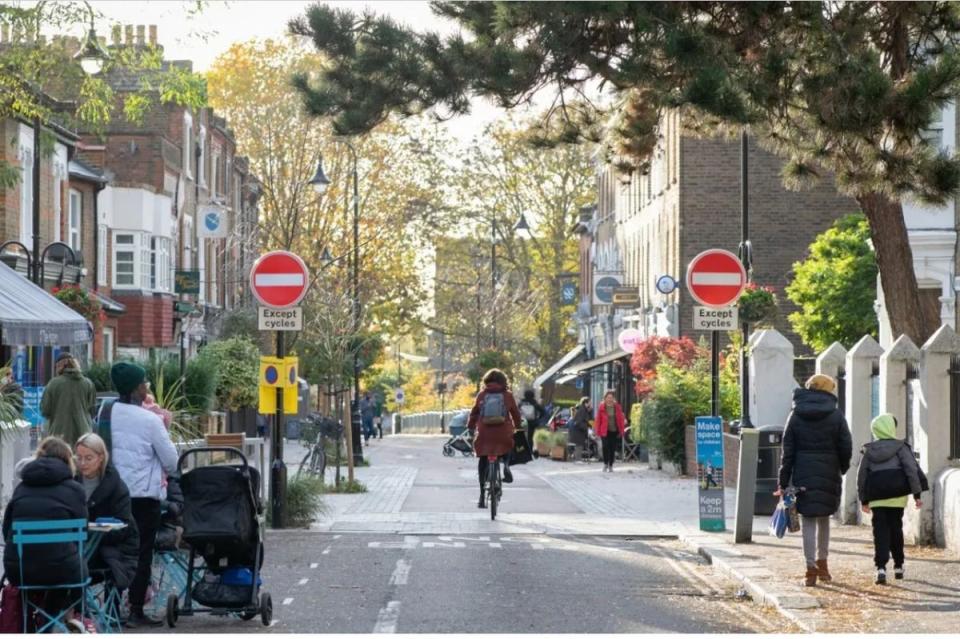What is an LTN? Study finds health benefits from low traffic schemes are up to 100 times greater than costs
A study has found that low-traffic neighbourhoods can create public health benefits as much as 100 times greater than the cost of the schemes.
The long-term study of active travel measures has found that the cumulative public health benefit of people being more active was estimated at as much as £4,800 per local adult over a 20-year period as against a cost per person to build LTNs of about £28-£35, or £112, depending on the type of scheme built.
The research is based on six years of surveys and thousands of people living in three outer London boroughs that introduced LTNs or similar schemes, found they prompted people to switch some trips from cars to active travel, although the effects were varied.
The study also found that the positive impacts, particularly for walking and cycling rates, were more noticeable after a few years of the schemes being introduced rather than immediately, indicating that councils should not determine an LTN’s success or otherwise too early.
The research, led by Prof Rachel Aldred of Westminster University, also suggested that the positive benefits tend to continue growing over time.
What is an LTN and what are the rules?

To quote Transport for London: “LTNs help to make streets around London easier to walk and cycle on by stopping cars, vans and other vehicles from using quiet roads as shortcuts”.
They are designed to stop places where families live from being used as a shortcut or rat-run for through traffic by blocking the roads off with bollards or flower beds. It is still possible to ride a bicycle through them and walk along the road. The road the LTN is on can be accessed in a car by residents.
London has had LTNs since the 1970s but a flurry of schemes have been implemented since 2020 as part of the Mayor of London’s plan for 80 per cent of all trips to be by active or sustainable modes by 2041.
Transport for London can provide funding for the schemes but it is up to local councils as to where they are placed.
What are the pros and cons of LTNs?
Transport for London promotes the schemes under the bill that they are safer, with most streets in the capital not built for the number of cars they now have.
More than 80 per cent of deaths on London’s streets are people walking, cycling or on motorbikes and mopeds, according to TfL data. By reducing the access of cars to residential areas the potential for collisions is lessened. They also arguably encourage more people to walk or cycle and can improve air quality.
Opponents argue that LTNs obstruct emergency services, push out traffic on to main roads and can hold up people who drive for a living such as delivery drivers and vans.
The Times reported that miles driven in Hackney rose by 28.7 million miles, or 11.8 per cent, last year, an increase above the London average.
“Any increases in traffic are unlikely to be permanent,” TfL said. “We’re paying close attention to changes in traffic levels and bus journey times in and around LTNs and comparing them with areas where LTNs haven’t been introduced. We may make changes to help traffic adjust, including changing traffic light timings or adding more signage.”
TfL also said it was working with emergency services to flag any changes to routes.
Where are there LTNs in London?
Boroughs to have LTNs include Camden, Croydon, Ealing, Hackney, Hounslow, Islington, Lambeth, Newham and Waltham Forest. Most boroughs have some implementation.
Outside the City of London, Hackney has the highest proportion of LTN coverage with 70 per cent. Bexley has the lowest with 4 per cent.
Are there plans for more LTNs?
Already leading the way, Hackney said last year it wants to make 75 per cent of its roads subject to LTN regulation. Since 2020, the borough has implemented 19 LTNs.
Hackney mayor Phil Glanville said: “This is the most ambitious plan in London, if not the most ambitious in the country, building on an incredible track record in this borough.”
The Waltham Forest Echo reported more schemes are likely in the borough in the next four years after a vote of approval.


